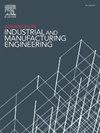Study on the influence of substrate preheating and deposition environment on the structural integrity of high carbon steel LMD parts of increased geometrical complexity
IF 3.9
Q2 ENGINEERING, INDUSTRIAL
Advances in Industrial and Manufacturing Engineering
Pub Date : 2025-06-07
DOI:10.1016/j.aime.2025.100167
引用次数: 0
Abstract
Laser Metal Deposition is finding growing industrial attractiveness thanks to its unique capability to locally restore worn metal components. In recent years, the industry is focusing on the application of metal Additive Manufacturing for the restoration of moulds and dies to improve process efficiency by reducing machine downtime and spare parts storage expenses. Although mould repair proved to be a cost-effective technological solution, the restoration of geometrically complex high carbon steel alloys through laser-based Additive Manufacturing still presents criticalities due to the low material weldability, high material oxygen reactivity, and high residual stresses generated by thermal cycling. This research work aims to analyse the influence of substrate preheating and the building environment on the structural integrity of steel specimens exhibiting 0.85 % carbon content and implementing geometrical features which are generally critical to restore by laser-based processes since they behave as thermal stress concentration. The performed preliminary observations highlight no delamination and no oxide regardless of process conditions. High-density (99.99 %) and crack-free high carbon steel depositions are achieved by reducing melt pool cooling rates during part manufacturing as a result of the increased environmental temperature surrounding the as-deposited material. Metallographic analysis demonstrates that carbide size decreases as cooling rates increase.
基体预热和沉积环境对几何复杂度增加的高碳钢LMD零件结构完整性影响的研究
激光金属沉积由于其独特的局部修复磨损金属部件的能力,正在发现越来越多的工业吸引力。近年来,业界重点关注金属增材制造在模具修复中的应用,通过减少机器停机时间和备件存储费用来提高工艺效率。尽管模具修复被证明是一种具有成本效益的技术解决方案,但由于材料可焊性低、材料氧反应性高以及热循环产生的高残余应力,通过基于激光的增材制造修复几何复杂的高碳钢合金仍然存在关键问题。本研究工作旨在分析基材预热和建筑环境对碳含量为0.85%的钢试件结构完整性的影响,并实现几何特征,这些特征通常对通过基于激光的工艺恢复至关重要,因为它们表现为热应力集中。所进行的初步观察强调,无论工艺条件如何,都没有分层和氧化。高密度(99.99%)和无裂纹的高碳钢沉积是通过在零件制造过程中降低熔池冷却速率来实现的,因为沉积材料周围的环境温度升高了。金相分析表明,随着冷却速率的增加,碳化物尺寸减小。
本文章由计算机程序翻译,如有差异,请以英文原文为准。
求助全文
约1分钟内获得全文
求助全文
来源期刊

Advances in Industrial and Manufacturing Engineering
Engineering-Engineering (miscellaneous)
CiteScore
6.60
自引率
0.00%
发文量
31
审稿时长
18 days
 求助内容:
求助内容: 应助结果提醒方式:
应助结果提醒方式:


